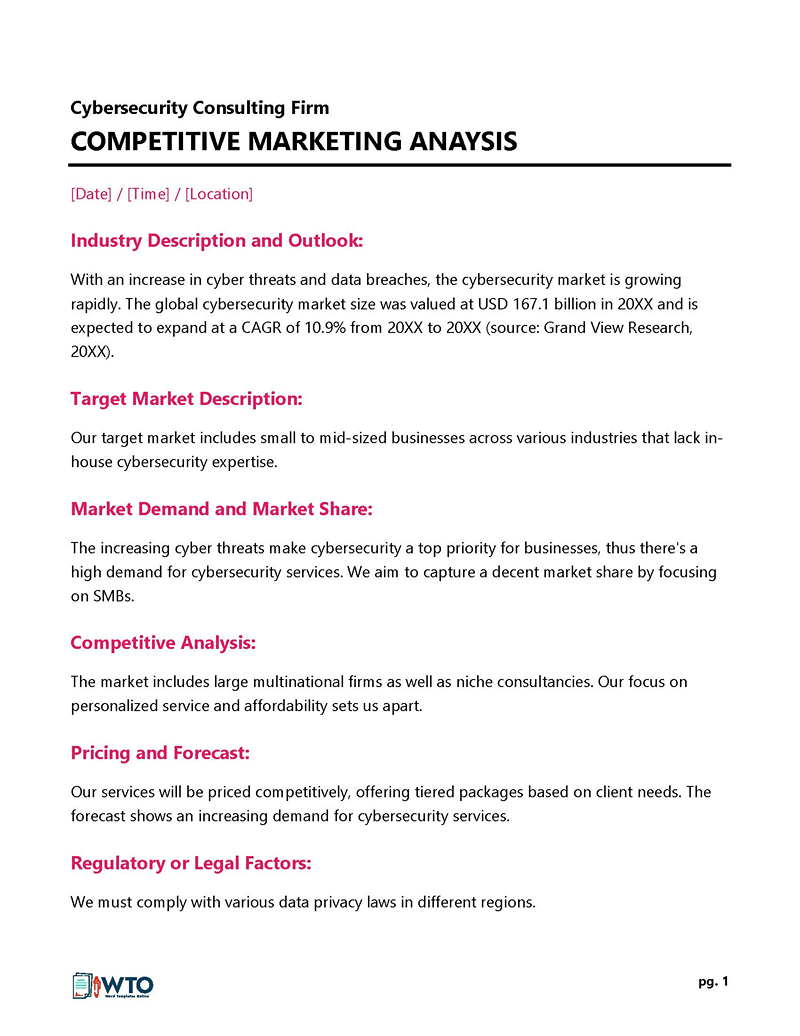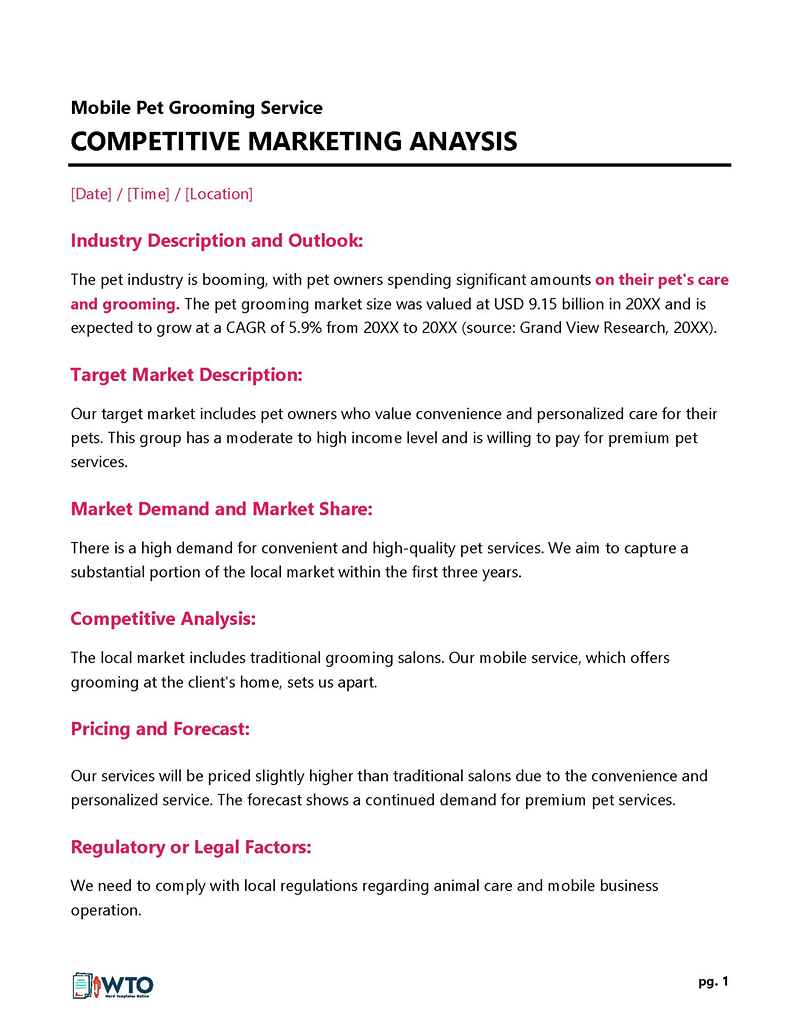Research plays an essential role in starting and managing a business. A thorough analysis of the market must be conducted before preparing a business plan. To determine whether a business idea is viable in a given industry, the market analysis examines a variety of factors, including customers, competitors, industry regulations, etc. Then, if it is started, the business will be well-positioned to attract a sustainable market volume and value.
Market analysis offers start-ups a chance to create an objective business plan with a higher chance of success than opening a business based on assumptions. This success will often be a good incentive, whether it is a sole proprietorship or partnership, and can grant you favor among investors and other financiers, such as banks. Depending on the size of the start-up, small businesses will often require a quick market analysis compared to larger companies, which have to conduct a thorough and detailed analysis.
What is a Market Analysis?
A market analysis is a formal qualitative and quantitative assessment of the current market’s conditions, target market, industry, and niche of a product or service to determine the economic feasibility of a business idea. It uses statistical data to identify the potential customers and their needs in a specific industry, their shopping habits, the amount they are willing to pay for specific products or services, the direct and indirect competitors, and the associated strengths and weaknesses.
Market Analysis Templates






Reason to conduct it
A market will typically be one of the earliest tools for strategizing in a business’s lifespan. It lowers the risk of entering an industry or business without much knowledge. A market analysis is an opportunity to understand the industry and the target market’s competition and strategize in terms of pricing and forecast. This way, a business can provide products, services, and solutions that customers will pay for, which will enable it to overcome its competitors.
Understanding the market and what customers need helps start-ups save resources spent on creating nonviable products or services. The analysis also equips the entrepreneur with information that can be used to make future decisions.
Pro tip: The aspects of the business on which a market analysis focuses will vary depending on the circumstances and goal of the analysis. For example, small businesses with in-depth knowledge of their customers do not require thorough market analysis and can focus on specific items, such as competitors in the sector. Also, suppose the goal of the analysis is to create a business plan to secure funding from banks or investors. In that case, a deep formal analysis must be conducted to ensure factually accurate data is used to back up projections and claims in the business plan.
Conducting the Market Analysis Successfully
A comprehensive market analysis should be based on extensive data from multiple aspects of the business. This will involve a lot of research, examination, and evaluation of information to reach well-informed conclusions on the status of the market at a particular moment. Due to the amount of information and workload involved, it is advisable to use a market analysis template for the process.
The following steps can be used for market analysis:
1. Segmentation
Segmentation is essential in analyzing a market. The number of segments and how they are organized will be determined by the type of business and the characteristics of the competitors. For example, a market can be segmented into the following groups:
1.1. Potential customer (volume)
The volume of a market represents the number of potential customers, and this should be included in market analysis. These figures can often be obtained from official business reports for established sectors but might require extensive research in a new market.
1.2. Market value (value)
The market can also be segmented based on the value of the specific market into which a company wishes to expand. Market value is given in monetary terms. The information obtained from market consultancy firms or government agencies must be included in the market analysis.
1.3. Methods for creating an estimate
Alternatively, the volume and value of the market can be determined through estimation. Two methods are used in developing estimates: the bottom-up method and the top-down method. A bottom-up method produces a global market value based on unitary values, while a top-down method starts with a global value and reduces it to unitary values.
1.4. Industry overview
The market analysis should have a section to document details about the current status of the industry and its trajectory. The industry can be defined according to size, trends, and potential growth. The industry overview provides detailed information about modern technology, practices, and business models, such as the transition from brick-and-mortar to online.
2. Target market
The next step is to define the target market. Note that the market and industry are two different things; the ideal customer represents the target market for a product or service. The target market is more specific. One industry can have multiple markets; for example, the car industry has markets for personal vehicles, security vehicles, medical vehicles, and sports vehicles. The market analysis should define the following aspects of the target market:
2.1. Market size
The target market’s size is determined by the number of potential customers, as opposed to the industry’s size, which is specified in monetary terms. This information can be obtained from state agencies or official business reports.
2.2. Demographics
Then, a demographic profile of the ideal client for a company’s product or service should be developed. This includes age, gender, income level, education, etc. The market analysis should include each of these characteristics of an ideal customer.
2.3. Location
The location of the target market is another essential aspect that should be mentioned in the market analysis. This will often be influenced by the size and model of the business; for example, online businesses have wider market access than physical outlets. Businesses can operate within a country, trade region, state, city, or county. Any other type of location should be clearly defined.
2.4. Psychographics
Another aspect that needs to be assessed is the target market’s psychographics. Psychographics define customers based on their attitudes, lifestyles, needs, likes, dislikes, and personality traits.
2.5. Behaviors
In the market analysis, the analyst should include customer purchasing and interacting patterns or behaviors. For example, shopping habits can include peak and low shopping days, months and seasons, shopping patterns like the combination of goods being bought, frequency of purchase, etc.
2.6. Trends
The market analysis should highlight any significant trends among the target customers because consumer habits are constantly changing. For example, an increased inclination towards one product over another, preference for certain features over others, etc.
2.7. Market need
The market analysis should also look into the niche the business taps into by addressing certain elements such as customer pain points and an overview of the business’s competitive edge. For example, Amazon’s niches are affordable prices and convenient delivery. Additionally, the market analysis can mention all the components of the current and potential niches to explain the competitive edge.
3. Test results
The market analysis should then provide a section to document the results of the initial market research. Explicitly discuss the research methodologies used for gathering the information and provide supporting statistics for the results.
4. Lead time
The time customers take to complete an interaction with the business, such as purchasing or receiving a service, known as the “lead time,” should be mentioned in the market analysis document. The lead time from singular orders to bulk orders should be indicated, and this information should be supported by the test results.
5. Competition
The following section will look into the business’s competition. A competitive analysis is a strategy that entails investigating the main rivals to learn about their goods, sales, and marketing strategies. It has many benefits, including the ability to put stronger business strategies into practice, ward off competitors, and increase market share. Competitive analysis should be conducted by observing the market from the competitor’s perspective. The following factors should be considered in the study: prices, quality, processes, add-on services, etc.
In addition, the following aspects of the competition should be documented:
5.1. Direct competition
The analysis should indicate the direct competitors, i.e., businesses that offer the same products or services to the same customers the business serves. An example of direct competitors is Nike and Adidas.
5.2. Indirect competitors
An indirect competitor provides different goods or services while still meeting the same customer needs as another business. A food vendor selling baked bread, for example, is an indirect competitor of one selling chickenburger patties. They both serve customers who want food, even though they sell different products.
5.3. How you are different
The market analysis template expounds on how the business and its products or services are different from the competition. This creates a competitive edge. Differences can emanate from multiple aspects such as pricing, location, additional features, or quality.
5.4. Strengths and weaknesses of the competitor
The analysis should then identify the competitor’s strengths and weaknesses. This involves a careful evaluation of how competitors operate their businesses. Sometimes a benchmark is necessary.
5.5. The window of opportunity
The “window of opportunity” signifies the appropriate time or conditions under which a business should enter the market. This information should be outlined in the market analysis report.
5.6. Barriers to entry
Barriers to entry prevent new competition from entering the market. Barriers to entry thus protect the business from being edged out by new entries. Barriers to entry include patents, location, unique technology, brand strength, regulatory barriers, substantial investment, exclusivity rights, etc. Each type of business will have its own unique entry barriers; therefore, a thorough analysis must be done to determine them.
6. Projections
Next, the market analysis should highlight the projections of different aspects of the business based on the analysis and research. If the analysis is being conducted for a business plan to be presented to investors, this can be a great selling point. Projections are merely educated guesses, and therefore absolute accuracy is not a consideration. However, note that the projections should be realistic and not misrepresented to get investments.
Projections should be given for the following:
6.1. Market share
Give an estimate of the company’s potential market share and customer base. Then, when giving market share projections, use a bottom-up approach by stating the course of actions, such as marketing, that will increase the projection figure.
6.2. Pricing and gross margin
Projections of prices and gross margins should be given. When setting the price, ensure that the number (price) is higher than the production cost of the product. Gross margin is given by the selling price minus the cost of production of the product or service. Note that prices do not always have to be lower than the competitor’s; businesses can set higher prices if they offer better products or services or have a competitive edge.
6.3. Forecasting
The next item that should be projected is the initial sales volume. Again, it is vital to place a time stamp on projections about sales. The market analysis report can include projections for the first five years, followed by year after year.
6.4. Regulations
Finally, list all the laws and regulations that the company must abide by before starting operations. Then, discuss how the business intends to be compliant and the applicable compliance costs in the market analysis report, if any.
Some Professional Tips
A well-conducted market analysis is useful in ensuring that the correct decisions are made when starting a business. The following items can be used to conduct a practical market analysis.
Use the internet
Market analysis involves a lot of research, especially when collecting data. The internet is an excellent source of raw data on demographics, competitor information, market volume, value, etc. Search engines such as the United States Census Bureau can be an effective way of getting and verifying information.
Be the customer
Always consider the customer’s perspective when analyzing aspects of the target market. This is an excellent way of creating objective strategies to solve customer pain points and gain a competitive edge over competitors.
Cut to the chase
Create a summary of the market analysis and include it in the document so that readers can review it to get a sense of what’s in the document without reading the entire document.
Conduct exhaustive market research
Be thorough when researching. A superficial market analysis is often as good as none at all. Take time to collect and assess information and draw conclusions.
Use visual aids
Aim to present statistical data using infographics and charts like bar graphs, pie charts, etc., as they are easier to understand when presenting the analysis.
Be concise
Be articulate and concise while drafting the market analysis report. Try to focus on customers, competitive edge, and projections, and place supportive data and statistics at the end of the document.
Relate to your business
Any data and information outlined in the market analysis report should be related to the business and its products and services. Create a document outlining the company’s position and its appeal to potential customers.
Common Methods for Gathering Data for Market Analysis
There are multiple sources for collecting the information needed for market analysis. Different types of information will be required for various types of industry analyses. While it is common to have difficulties finding some particular information, most types of data are easily available from, the following notable and reliable sources:
Your current customers
For existing businesses, feedback from existing customers is a reliable source of information. Feedback can be obtained from online surveys, social media interactions, or questionnaires.
USA.gov
Information can be obtained from the official United States of America government websites. The site contains different types of information that can be used for market analysis.
U.S. small business administration
Otherwise known as the SBA, it is a notable source of information about different industries. In addition, they provide industry guides that can be referenced when conducting a market analysis.
Bureau of labor statistics
When developing projections for market share, the Bureau of Labor Statistics (BLS) is an authentic source of information to get a history of different types of industries and future projections about the sectors based on existing information.
Commerce.gov
Researchers can consult the U.S. Department of Commerce to gather different types of information. For example, the bureau contains information about different industries such as automotive, bio-processing, textile industry, etc.
Concluding Thoughts
A market analysis effectively assesses the current market conditions, target market, market needs, competition, barriers to entry, and regulations before starting a business and preparing a business plan. The degree and depth of the analysis are often dependent on the size of the business and its purpose. Startups seeking funding are required to have a business plan, which ultimately requires one. It is suggested to use a template to expedite the process and save time because conducting a market analysis can be a time-consuming and difficult task. The analysis should use raw data and show how a business or its products and services are superior to those of its competitors and how it intends to solve customer needs.












